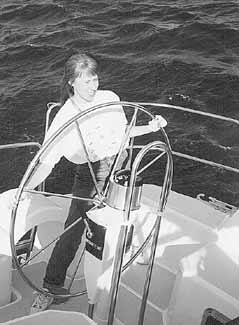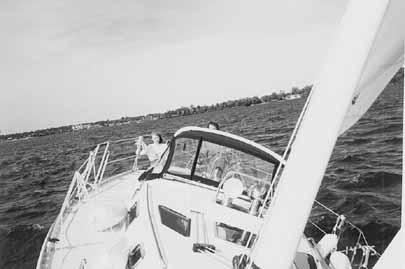

ON DECK
SAIL PLAN - UNDERWAY
SAFETY
INTERIOR
CONSTRUCTION
CONCLUSION
By Thom Burns
How do you define the perfect coastal cruiser? Wouldn’t it be nice if it could also take you across some blue water in comfort and safety without a big crew? We sailed the Freedom 35 from the perspective of a cruiser with room for four or, in a pinch, six to sleep, but which is manageable by a couple, or can be effectively single-handled. We were also looking for performance.
This David Pedrick design, first introduced in 1992, has been very successful with 30 boats built in the first two years. We sailed hull number 47, a shoal draft version, with Gary DeSantis of Sailor’s World. The breeze was a bit strong at 20 - 22 knots with gusts in the 29 - 30 range. I brought along Alexis Olson, a young, small sailor with limited bigger boat experience who also sailed with me on the Freedom 24 earlier in the year. We thought she would be a good test of just how easy this boat is to handle in these conditions.
Alexis Olson at the helm of the Freedom 35
going upwind.


Note the clear, unobstructed decks, several ports and hatches, and two dorade vents on the Freedom 35. Quality hardware lowers your maintenance.
One of the most striking impressions about the Freedoms in general and the 35 in particular is how clean and uncluttered the deck is. The carbon fiber, freestanding mast eliminates the shrouds, the backstay, the spreaders, the chainplates and associated gear. The mainsheet, working jib sheet, halyards and reef lines were led through turning blocks and Lewmar stoppers to a couple of Harken winches on the cabin roof within easy reach of the cockpit.
The cockpit while not huge is comfortable. The 44 inch diameter Edson “Destroyer” wheel gets your attention. Lines stow in flip open halyard boxes. Cockpit stowage is provided in twin lazarettes and a large locker to starboard. The crowned helm seat is removable and stowable. The open transom steps and swim platform allow for easy stern access or dinghy boarding.
Another big advantage of having no shrouds or backstay to chafe or hang up on is a large, full-batten main with a lot of roach. This powerful sailplan proved to be very manageable. The standard foresail is a self-tacking Camberspar working jib. In lighter air, various overlapping genoas are available for more power. This Freedom 35 carried a self-tacking 105 genoa on a Furlex roller furler.
We found the boat to be very responsive under power. The helm feels good with no vibration under power and a slight weather helm under sail. Freedom has done a good job on their bearing style steering system. The main went up without a hitch. I had chartered a Freedom 44 in the early eighties for two weeks. The full-batten cars on today’s mains are dramatically better than when I struggled with them back then. We were overpowered in the gusts going up wind with the full main up. Before reefing we decided to fall off to a broad reach and jibe a few times. With a hard, fixed vang, no backstay or shrouds, this is a smooth operation even in a brisk 20 plus knot breeze. We were very impressed with the downwind speed on a reach. The boat was heeled less than 10 degrees and cruised at or near 8 kts, hitting 8.6 on one tack and 8.45 on the other in the gusts. We then brought the boat around into the wind; Gary reefed it from the cockpit in short order.
Here is where the simplicity of the rig really showed off. Not only had the reefing gone without a hitch and we were no longer overpowered, but it was so simple to tack through 80 - 85 degrees upwind. With the main adjusted, the traveler centered and the jib self-tacking, the helmsman simply tacks upwind, as often and quickly as desired. Gary moved into his coaching mode with Alexis going upwind. Within 10 - 15 minutes, he had her tacking and staying in the groove on both upwind tacks. It takes a comfortable degree of knowledge of and confidence in your equipment for a dealer to turn his boat over to a 17 year old sailing reporter and then bring her up to speed in such a short time.
One of the factors in the performance of most keel boats is how flat you can sail them. The flatter you can sail them the easier they are to control. This added control equates to greater safety and generally more speed. In addition to the carbon fiber mast being simple, it is also lighter. Less weight aloft makes it easier to maintain the boat in a more upright position. Another safety issue is the control that can be exercised without leaving the cockpit. On the Freedom 35 virtually every sailing and motoring function can be performed from the cockpit. The swim platform on the stern makes dinghy access safer and overboard retrievals easier.
The open transom is often a defining difference between open ocean vessels and coastal cruisers. Freedom has defined and built a coastal cruiser in the 35.
Freedom has used enough cherry and teak to keep the boat elegant inside.
They’ve balanced the lighter woods to give it a “Light and airy” feel. There are
five opening ports and a main hatch in the main saloon. A luxurious mix of
cherry panels and trim and a holly and teak sole functionally decorate the main
saloon. There is 6’2” headroom, a drop-down table and stowage behind louvered
doors outboard.
The galley is L-shaped. It has large, deep, stainless sinks. The icebox is large
and well insulated with a separate compartment for serious provisions. The
gimbaled stove is a Force Ten complete with oven and broiler. The 27 hp engine
is below the sinks. The engine seemed well insulated and very quiet. I had read
that an early test boat had been noisy, this one was not.
The Nav Station is simple and functional with sufficient area for chart viewing.
The vertical area for instrumentation is well placed near the electrical panel
located above the starboard settee. This is convenient for wiring from the nav
station.
The cabins are particular strong points on the Freedom 35. Long berths, lots of
light and air, and privacy mark both the forward and aft cabins. The forward
cabin has two opening ports and a full-size hatch while the aft cabin sports the
same number and a generous athwartships full-bed. The woodwork and cabinetry are
first class. The head located to starboard of the companionway has a separate
shower stall and its own wet locker.
The hull construction is an endgrain balsa sandwiched between multiple layers of unidirectional and biaxial fiberglass. The fiberglass is hand-laid and is bound with vinylester and polyester resins for optimal strength-to-weight ratios, blister and fade resistance. When I’m looking at a new boat, hopefully there is evidence of superior workmanship beneath the surface. Climb into the deep, aft starboard lazarette and look at the hull to deck joint, steering gear and rudder post. If that bullet-proof hull to deck joint doesn’t make you feel good, you’re looking at the wrong boat. The 3” reverse flange is bonded and bolted on 6” centers with stainless carriage bolts, through the aluminum toe rail. While the interior of the Freedom 35 is elegant with cherry and teak, upkeep on deck is kept to a minimum by quality Harken and Lewmar hardware and very little teak. The handrails are close to no maintenance. They are made from 316 grade electropolished stainless. The toe rail is anodized aluminum.
The Freedom 35 is a well-built, cruising boat which can be easily handled by a non-atheletic couple or single-handed. It affords nice creature comforts while maintaining an essential degree of privacy for two couples or a family out for a couple of weeks. The simplicity of the rig provides for a very uncluttered deck and excellent sailing performance. Glenn Yarborough, after he had circumnavigated the second time, bought a Chinese style junk rig for his new 35 footer because of the simplicity of it. The folks at Freedom must have been listening to his ballad, “I Coulda Been a Sailor.” Their rig, while not nearly as old as the Chinese style junk rig, is also self-supporting. The similarities pretty much stop there. The Freedom 35’s rig is high tech, light and supports a far more powerful sail plan. This sail plan, 740 square feet, compares favorably to several other 35 footers that I checked. These other boats were all in the 610 to 620 square foot range. When a company combines a powerful sail plan, a lighter, simpler rig aloft and remarkable ease of handling they may be close to the ideal coastal cruiser. I would feel very comfortable and safe taking this “coastal cruiser” all over the Great Lakes and even across the ocean.
Thom Burns publishes Northern Breezes and Sailing Breezes.
Sailor's World: 952-475-3443 or Freedom Yachts: 800-999-2909. Freedom Yachts
All contents are copyright (c) 1996 - 2003 by Northern Breezes, Inc. All information contained within is deemed reliable but carries no guarantees. Reproduction of any part or whole of this publication in any form by mechanical or electronic means, including information retrieval is prohibited except by consent of the publisher.